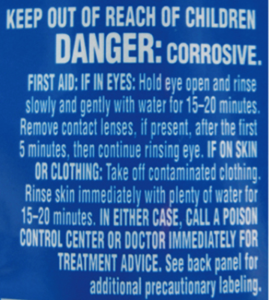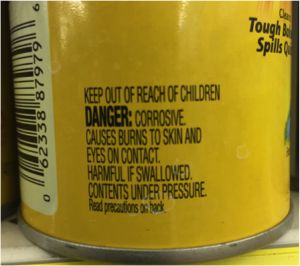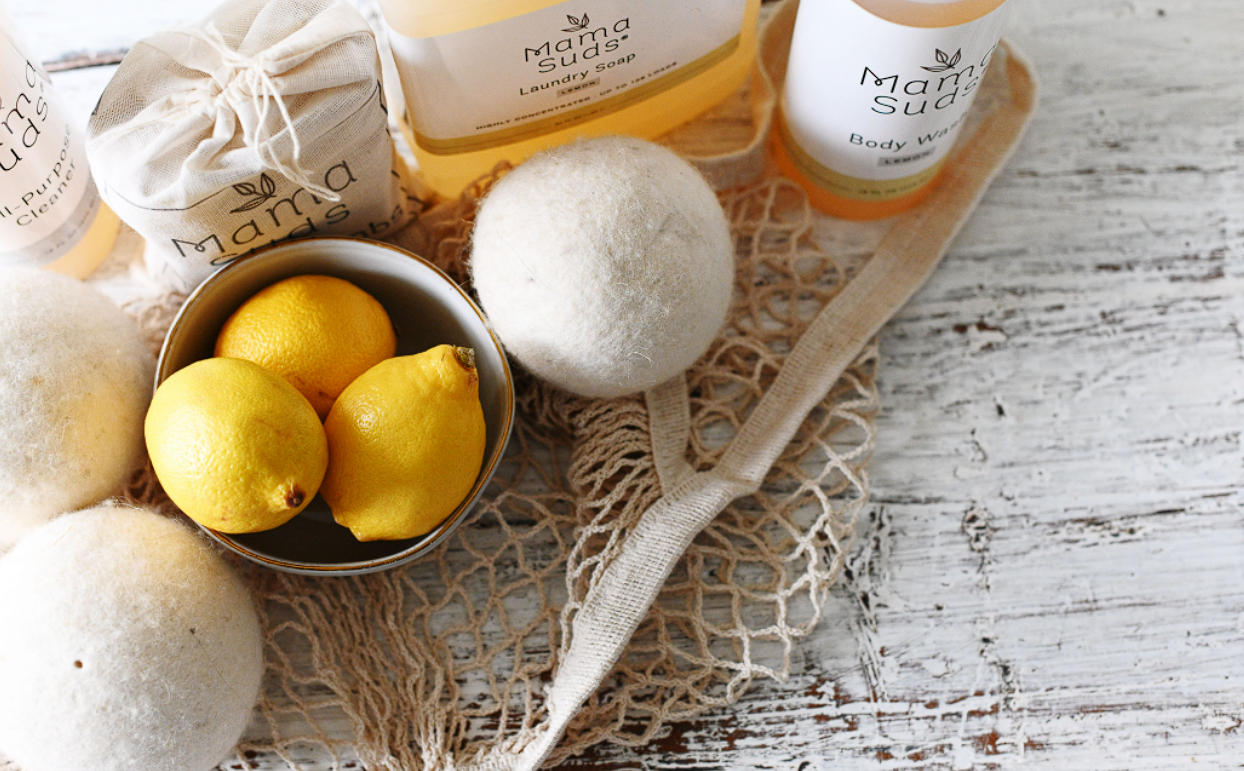
The CleanSuds Blog
Where education and truthful facts are easy to come by.

Helping Senior Loved Ones Live in a Clean and Eco-Friendly Home
• Encourage the elimination of items that do not give them joy to reduce their risk of falls.
• Seek professional help or assistance—Medicaid offers homemaker services for tasks like cleaning, laundry, and shopping essentials.
• Provide adequate storage space for seniors to help them keep their home tidy.
• Professional deep cleaning services should be offered to ensure mold and other health threats are absent from the home.

4 Smart Ways to Reduce Your Carbon Footprint
All of our actions have consequences, but some of these consequences last far longer than others. A desire to get things done faster or to increase our comfort even slightly can have massive repercussions for the environment. If you're looking to reduce your carbon footprint, then these are four easy ways to do it.
Cut Back on Meat
Meat consumption has some very intense impacts on the environment. Just a pound of beef can require nearly 2,000 gallons of water. There are also other things to consider such as deforestation. If you're not ready to give up meat completely, you can still cut back your consumption. Reduce your meat consumption as much as you can. You can start by only eating meat on certain days of the week. As you open yourself to more fruits and vegetables and other forms of protein, you might find yourself feeling much more energized.
Switch to Energy Star Appliances
Being environmentally friendly doesn't mean you have to get rid of all conveniences. You can help the environment by switching to Energy Star appliances. Not only can these appliances help reduce carbon emissions, but they'll also help reduce air pollution and even save you money. You can easily identify Energy Star appliances, and they can include your fridge, your washer and dryer, and more. This brand can really make a difference in terms of reducing your carbon footprint.
Drive Less
Cars have become such a pinnacle of society that it's easy to forget how much damage they can do. Pollutants from vehicles shouldn't be overlooked, especially when there are so many alternatives. You can try biking, using public transportation, or even walking when the weather allows it. You can also try setting up a carpool with your neighbors to reduce the number of vehicles on the road.
Plant a Tree
Another smart way to reduce your carbon footprint is to plant a tree or garden. Plants not only absorb carbon dioxide from the air but also add beauty to the surrounding environment. In addition to environmental benefits, planting a tree is a great way to add shade to your yard, improve the look of your property, and even memorialize a favorite pet. Trees, vegetable gardens, and flowers all make great additions to any home. If you live in an apartment or urban area, then you could look into your options for contributing to a community garden or green roof.
You might have to make a few sacrifices in order to reduce your carbon footprint. However, these are small in the grand scheme of things, especially when you consider that the purpose is to help the earth's longevity. Talk to your friends and family about your new eco-friendly lifestyle and do your best to encourage them to follow your example.
Check out our great selection of eco-friendly household cleaning products to keep your home as environmentally conscious as possible!

Show Mom You Care With An Eco-Friendly Gift on Mother's Day
Sixty-two percent of consumers in the U.S. and U.K. are buying eco-friendly products for a healthier life. Living an eco-friendly lifestyle is becoming increasingly popular among many cohorts, and moms are getting on board as much as anyone else. An eco-friendly gift may be just what your mom is hoping for this Mother’s Day.
A Plastic Free Kitchen
The kitchen is a great place to start going eco-friendly and plastic free for so many reasons. Plastic may seem like a convenient tool for packaging food and more, but storing food in plastic containers causes small amounts of plastic to leach into the food, a process which is increased when exposed to heat or when the foods are fatty, salty or acidic. Not to mention the environmental impacts of single use and even reusable plastics. Fortunately, many reusable and eco friendly products exist to replace disposable kitchen plastic. Curating a little gift basket of eco-friendly kitchen items could be the perfect gift for a mom who loves to cook. Include items such as cloth grocery bags, beeswax food wraps, silicone ziplocs and a reusable mug or cold cup for on the go.
Green Luxury
So many mothers love receiving soothing self care products to thank them for all the hard work they do as moms. But many of our favorite luxury products include ingredients that can have adverse health and environmental effects. Paraffin based candles, according to researchers at South Carolina State University, will pollute indoor air with several toxic chemicals that can lead to respiratory problems. Beeswax and soy candles, however, do not contain the same chemicals, and can be burned safely without risk of health problems. Make a quick and easy sugar scrub in a reusable glass jar, and combine it with a book and a safe-to-burn and eco-friendly soy candle for a mom who’d like to put her feet up and read a good book more often.
Sweet and Simple
Some of our mother’s are difficult to buy gifts for, but there’s almost nothing a mom appreciates more than a heartfelt and handwritten note from their child on Mother’s Day. Many companies now make plantable greeting cards made from recycled paper materials. Plant seeds are inserted directly into the paper so that once the note has been thoroughly appreciate, your loved one can plan it in their garden. The paper decomposes and a flower or vegetable grows in its place. Along with a sweet note, you can personalize a plantable card with a favorite fair trade chocolate bar or two, a potted plant, or maybe even an e-gift card to save paper and avoid buying something she might not use.
Mothers work hard for their families every day, whether their children are small or all grown up. Make sure to show how much you appreciate her this Mother’s Day with a beautiful gift that protects both her health, and the earth that her children and grandchildren will inherit from her.
contributed by Sally Preston
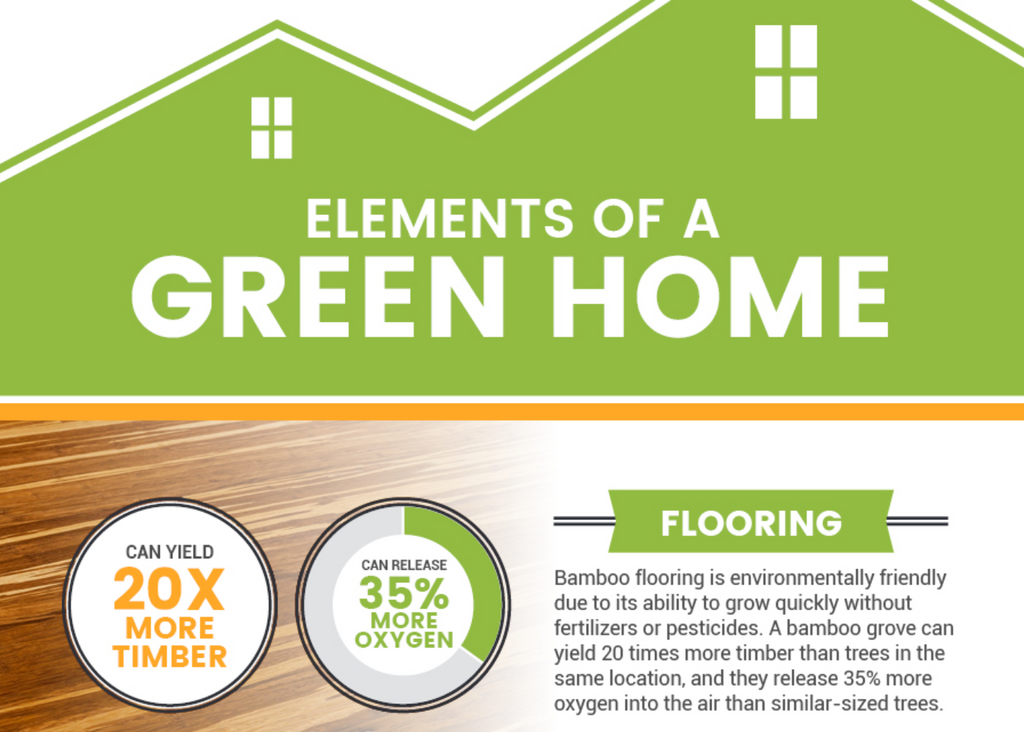
Green Living: Creating A Cozy, Eco-Friendly Home
Written by Tony M.
With sustainability being at the forefront of everyone’s minds in recent years, doing your part to contribute to a healthy environment is more important than ever. Luckily, going green has a wealth of advantages to offer every homeowner who makes the switch. From insulation to flooring (and everything in between), here are a few ways you can upgrade your living spaces to contribute to that bright, green future.
Beautiful Bamboo Flooring
One of the major problems facing our planet is deforestation; with demand so high and growth so slow, bamboo provides an excellent, sustainable alternative to traditional hardwood floors. It can grow at incredible rates without the use of fertilizers or pesticides: a bamboo grove can yield 20 times more timber than trees in the same location, and they release 35% more oxygen into the air than similar-sized trees. If you simply must have that hardwood floor look, consider ecological bamboo in place of expensive mahogany.
Wonderful Windows
A home’s windows are its first line of defense against cold and heat; they can also be its largest energy leech — if you suffer from extreme monthly energy bills, it may be due to your windows’ U-factor. Defined as the measure of how well a window insulates (and therefore how well it prevents heat from escaping), the U-factor rating system uses a scale of 0.20 to 1.20. The lower the number, the better insulated your window. Since energy leeches contribute to the size of your carbon footprint, installing well-insulated windows with low U-factors can help the environment and your wallet.
Laudable Lighting
With technology advancing every day, the emergence of light-emitting diodes (LEDs) has had a huge impact on modern society. And, best of all, they’re remarkably green! Residential LED light bulbs use at least 75% less energy and last an astounding 25 times longer than incandescent lights. Though the initial cost might be higher, they pay themselves off dozens of times over and reduce energy waste.
Impressive Insulation
After your windows, your attic is a home’s largest offender for heat and energy loss: the U.S. Department of Energy estimates that 44% of home energy use goes toward heating and cooling. Since an attic with poor insulation could be leaking air — and insulated buildings in the U.S. have been proven to reduce CO2 emissions by 780 million tons — one of the best ways to minimize your carbon footprint and save money on those energy bills is to ensure your attic is well-insulated.
Powerful Plumbing
Your toilet is the main source of water use in your home, sometimes using (and wasting) six gallons per flush. Making the switch to efficient, low-flush models can reduce your water usage by 20 to 60%. A toilet that uses less water will still provide equal or superior performance, and it goes a long way towards reducing pollution.
Best of all, you are not alone in these efforts: nearly 84% of respondents in a 2017 survey stated that living in a sustainable, eco-friendly home is important to them. If we are all able to commit to a greener future, both our personal lives and the environment will grow and blossom as a result.

Running an Eco-Friendly Household Is Not as Hard as It Seems
There's a guy on social media who takes plastics out of the ocean and makes them into useful things to sell for operating money. Many people read this and decide they'll go green. Need to know how to begin? You can start in your own home.
In the Beginning
Having an eco-friendly household isn't as hard as it seems. Take cloth shopping bags to the grocery. Take a Mason jar when you want a soft drink or a ceramic mug or thermos for coffee. If you do, you won't be using foam cups and plastic lids. Use glass storage bowls in place of plastics and Tupperware.
Beyond these simple changes, you can also take steps to invest in eco-friendly technology and renewable energy. Switching to solar power reduces greenhouse gases, which will also minimize your home's carbon footprint. If possible, see what your options are for installing residential solar panels and using other energy efficient methods of powering your home. You can also look for ways to minimize water usage in your home. One option is to install energy-efficient plumbing on your property. Even switching to a submersible pump can help reduce energy usage in your home.
Reduce Plastic Use
You can make an effort to reduce plastic waste in your home by recycling and using other materials. Instead of plastic, try using glass. We know it's difficult to find glass bottles, but they're out there. Use your own glass containers to buy from the bulk section at the grocery. Bypass bottled water and instead use your own in a glass container.
If there simply is no way to use glass, then reuse your plastic. Use your plastic containers for organizing the paper clips and rubber bands on your desk or your hairpins and ponytail holders on your vanity table. You can also use plastic containers to hold change or organize the nails, screws and bolts in the tool chest. There are so many reusable plastic items that can be recycled and end up in landfills instead. If you cannot find the time to recycle these items yourself, see if you have friends or a local volunteer group that can help out with this.
Eco-Friendly Cleaning Products
As you make an effort to reduce and recycle plastics in your home, you can go green by using natural cleaning products. White vinegar makes a good fabric softener, and it can be used for cleaning the kitchen counters and the toilet. Baking soda cleans teeth, the toilet and sink drains, and it freshens carpets. Lemon mixed with baking soda cleans the garbage disposal as well as windows.
Decluttering Your Home
Decluttering your home is the first step to creating an eco-friendly home. It allows you to sort through your things and get rid of what you never use. You can either donate what you don't use to a goodwill store or if you want to keep it for future use you can put it in storage. Either way, removing the clutter from your home will streamline your organization efforts and it will prevent you from buying things you don't need. Instead of buying new furniture, repurpose what you have and recycle whatever you can. It will not only move you along the eco-friendly path but it will save you money in the long run.
Other Green Habits
Other means of going green include incorporating these habits:
- Using LED light bulbs, which last up to 13 years
- Doing the wash in cold water
- Drying clothes on a clothesline, which helps garments last longer and smell great
- Compost leftovers past their use-by date for garden fertilizer
- Walk or bike instead of driving
Living an eco-friendly life isn't hard to do. Once you begin, you'll wonder how you ever lived any other way. You'll have lots of fun finding ways to lower your carbon footprint and save the Earth.

Glamorous Green: Decorating an Eco-Friendly Space
Decorating a home can be an intimidating process for anyone. Trying to be eco-friendly when designing a new space adds an additional challenge. Luckily, eco-friendly home décor has come a long way, making it totally possible to create an ethically sourced design without compromising on style. Keep reading for some tips on making your green space look its best.
Buy Used
One of the easiest ways to keep your carbon footprint small is to buy pre-loved furniture and home décor. Start by checking eBay and Gumtree, which have fantastic vintage pieces added every day. You can also check your local thrift stores and use social media to see if anyone has pieces they’re looking to sell. Although secondhand furniture may not seem as exciting as getting something new, vintage pieces actually make your space unique. You can also always DIY the furniture to make it fit your space better. With so many tutorials on YouTube and blogs, you should be able to find a method that will work best for your renovation.
Think Before You Paint
Many people begin any room makeover by putting on a fresh coat of paint, as it’s one of the most affordable ways to change up a space. If you’re looking to design in an eco-friendly way, however, you should take the time to research the type of paint to use. Many paints contain VOCs, or volatile organic compounds, which release toxic emissions into the atmosphere for years after they’ve been put on your walls (EPA). This is not only bad for your family, but also detrimental to the environment. VOCs used to be critical to the paint-making process, but this has changed in recent years. When you select your new color, just make sure to buy one that is clearly labeled “low VOC.” In fact, some brands have no VOCs at all!
Take on a Project
One of the coolest ways to make your home more eco-friendly is to take on some DIY projects that are both energy efficient and aesthetically pleasing. For example, you can create a water wall with a collection of beautiful mason jars. Simply place the Mason jars on a window that receives a lot of sunlight. The water will then absorb heat during the day and release it at night, keeping your house cooler while you’re awake and more comfortable while you’re sleeping. You can even paint the jars so that your room is filled with colored light, creating a stained glass effect. Alternatively, you can just mix some food coloring into the water.
Even easier than a DIY is splurging on a bunch of houseplants. They’ll purify your air and look beautiful while doing it. Look through the home design inspiration here to get ideas for houseplant placement.
Avoid Normal Curtains and Carpet
Standard curtains don’t do a whole lot to control the temperature of your room. By investing in thermal curtains, you’ll cut down your energy bills for years to come. If there is a certain look that you absolutely love, you don’t have to sacrifice style. Simply buy a plain thermal curtain lining and place it behind the decorative curtains of your choice.
You may also wish to consider investing in hardwood floors instead of carpet. Carpet is not only full of pollutants and chemicals that release toxins into your home, but also harms the planet during the manufacturing process. And even the best carpets need to be replaced every ten years or so. Although real wood, the most environmentally-friendly choice, can be pricey, it will hold up well over time and increase the resale value of your home.
Although decorating a space in an environmentally friendly way can be a challenge, it’s worth it to know that you’ve helped your planet while also beautifying your space. Grab a paintbrush and get started today!
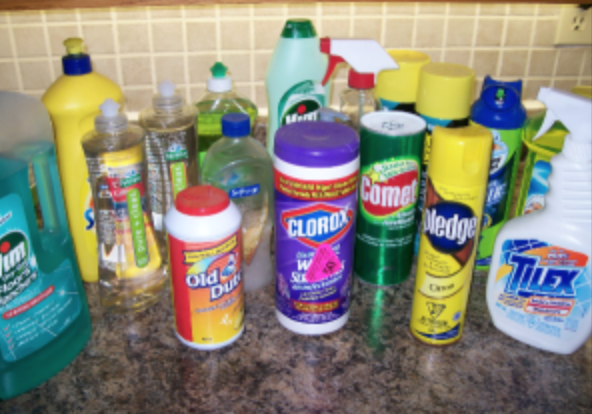
How to Switch to Safe Cleaners in 3 Easy Steps
Today's post is about ditching your cleaners. People have a lot of cleaners. There is a specific cleaner for every nook and cranny in your home. Not only is that a lot of product that is most likely harmful to your health and to our environment, it's a LOT of plastic.
Do you really need ALL those products? You will quickly learn that you don't. Do you know what else you will learn? You will learn that after a month or two after ditching your old products and switching to green products, you will have a hard time walking down the cleaning aisle at the grocery store. Seriously. The fumes will overwhelm you. Today you might be skeptical because you LOVE the smell of your products, but after you learn what is in them and your nose adjusts to the actual smell of "CLEAN" and the natural smell of essential oils, you'll be walking past the cleaning aisle holding your breath.
So how many different cleaners do you have? Seriously, go look. Go under your sink in your kitchen and count how many cleaners you have.
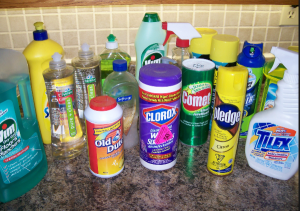
This is what my cleaning products consisted of before my cleaners went green.
We learn very early on in life to stay away from things that will hurt us. At some point, companies in our country have decided that products that will hurt us are okay if we don't overuse them or if we don't use them very often. I couldn't agree less. Which leads me into:
How to Switch to Safe Cleaners in 3 Easy Steps
Step 1: Ditch products that have warning labels on them.
Small quantities of hazardous substances can accumulate over time to reach dangerous levels and contaminate the air, our water and soil. Others can have a more immediate effect- like poisoning, if discovered by our kids or pets. If the label says, CORROSIVE, FLAMMABLE, or TOXIC/POISON it is considered household hazardous waste and should be disposed of (properly).
This is the warning label on bleach.
You will most likely find these warnings on oven cleaners and products that unclog drains. These labels and symbols warn us about acute health hazards associated with a single or short-term exposure to chemicals in the product. What about the long term? What if we are exposed to cleaning products and their residues at low levels on a daily basis?
*side note: all products will have a caution statement on them. These are okay. They are legally required to be on all products.
Step 2: Ditch products that have ingredients with numbers attached to them.
Why? Theses are typically artificial chemicals that have been added to change the product's appearance or shelf-life. This is bad news for our planet. The more an ingredient is processed the more damage it does. Our water supply gets increasing polluted when these toxic chemicals get flushed out of our homes and into our ecosystem. It is a vicious chain of events that affects our water, animals, plants and people. Not all ingredients with numbers are necessarily a health concern, but what should bother you is the fact that it synthetic and is an environmental concern.
Step 3: Ditch products that say 'fragrance' or 'parfum'
The products in your home that list fragrance or parfum as an ingredient are most likely synthetic fragrances that contain phthalates. (If a company is using phthalate-free fragrance they will definitely tell you). Most phthalates (actually pronounced thal-ates) are a group of chemicals in a gajillion of products in your home.
Concerns have been raised about phthalates because studies have found a link between phthalates and thyroid hormone levels in humans, and between phthalates and male reproductive health. Phthalates can be found all over your house because they are in almost every product AND THEY ARE NOT REQUIRED TO BE LISTED ON THE INGREDIENT LIST. Phthalates are disguised under the word "fragrance". They are so widely used it's nearly impossible to eliminate them from your life, but there are some steps to reduce your exposure by eliminating products from your life. No doubt, this is difficult and daunting at first but if you do it slowly you can gradually take this toxin out of your home. I took the time to look at the labels and eliminate the products that said the word "fragrance" on them. If there wasn't a full ingredient list, I searched for it. Here is another article I wrote about fragrance and air fresheners.
There you have it. Three easy steps. It's just a start, but once you start you'll create momentum and soon your household cleaners will be healthy and eco-friendly! Are you interested in learning more about how to read labels and become a ingredient ninja? Have more confidence when you go to the store and buy cleaning products? Learn how not to be duped by companies that act like "green" companies (aka green washers)? Want to know which products work (not just my products!)? I can totally help you... I am just finishing up creating my 10 Day class called EcoCleaners 101. If you're interested in being notified when you can sign up for this class opt-in below. Just for opting in, I will send you my Top 5 Most Important Products for SAFE & ECO-FRIENDLY CLEANING!





